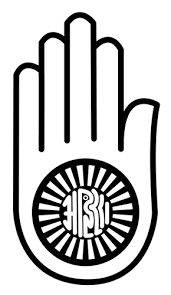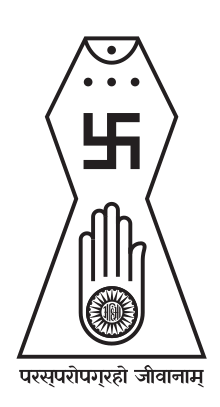The Jain Symbol is a collection of several symbols, each having a deeper meaning. In its comprehensive form, it consists of a moon crescent, three dots, Swastika, the palm of the hand with a wheel inset and an outline encompassing all these symbols.
The outline of the symbol symbolizes the universe. The lower part of the symbol represents the seven hells. The middle part of the universe contains the Earth and the planets. The upper part contains the heavenly abodes of all the celestial beings and abode of the Siddhas. Jains believe that the universe was neither created by anyone nor can it be destroyed by anyone. It may change its form, but otherwise, it has always been and will always be there.
The Meaning of raised hand
The raised hand means stop. The word in the center of the wheel is “Ahimsa” which means non-violence. The two together signify the importance of careful thought before action and also non-violence in thought, speech, and action.
 The wheel in the hand shows that if careful thought does not precede actions, and extreme non-violence is not adhered to, then humans are destined to follow the cycle of birth, rebirth, and death just as a wheel goes round and round.
The wheel in the hand shows that if careful thought does not precede actions, and extreme non-violence is not adhered to, then humans are destined to follow the cycle of birth, rebirth, and death just as a wheel goes round and round.
The four arms of the swastika represent birth into any one of the four destinies: heavenly beings, human beings, animal beings, and hellish beings during the incessant cycle of birth and death. Humans should aim for liberation from this cycle and in order to do than they should become the pillars of the four-fold Jain Sangh. The four pillars of the Jain Sangh are sadhus, sadhvis, sharvaks, and shrviks. This means that first, we should strive to be true shrvaks or shraviks, and when we can overcome our social attachments, we should renounce the worldly life and follow the path of a sdhu or sdhvi to be liberated.
The Meaning of the three dots above the swastika
The three dots above the swastika represent the three jewels of Jainism: Right Faith, Right Knowledge and Right Conduct which need to be practiced in tandem to achieve liberation. The right knowledge means having the knowledge that the soul and body are separate and that the soul, not the body attains salvation. The right faith means one must have faith in what is told by Jinas. The right conduct means that our actions should be void of attachment and hatred.
At the very top part of the Jain Universe, the symbol is a small curved arc. This arc represents the abode of the Siddhas. It is the final resting place of the liberated souls. The dot represents a siddha. In order to achieve this stage, a soul must destroy all the attached karmas. Every living being should strive for this state of the Salvation or Liberation.
Swastika is an auspicious symbol also known as sathia and is drawn at the beginning of all religious ceremonies. Shri Vatsa an auspicious symbol on the upper chest of all 24 Tirthankaras shows compassionate universal eternal love for all living beings.
Nandavarta, a complex form of swastika represents higher meditative attainment.
Vardhamanak an earthen bowl sealed within another earthen bowl is used as a lamp signifying light banishing darkness.
Bhadrasan, the royal throne is a seat of honor for evolved souls.
Kalasha, the holy pitcher with two divine eyes is present in every auspicious ceremony. Meen Yugala, the fish couple shows the flow of divine life in the cosmic ocean.






